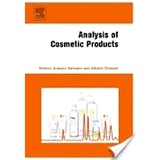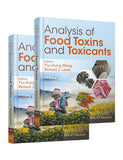Sensory and Instrumental Evaluation of Alcoholic Beverages By Authors: Hildegarde Heymann Susan E. Ebeler
Description
Sensory and Instrumental Evaluation of Alcoholic Beverages introduces the value of sensory analysis to the alcoholic beverage industry through the detailed lens of sensory analysis techniques. From traditional methods, to the most modern rapid methods, this book presents comprehensive insights and applications.
Analytical methods for identifying and assessing the flavor compounds present in the beverages are included that address both volatile and non-volatile techniques, along with rapid methods of assessment. Case studies highlight the testing of different types of alcoholic beverages running the entire gamut of methods and the appropriate subset of methods. Also included is information of data analyses with the appropriate R-codes to allow practitioners to use the book as a handbook to analyze their own data.
Key Features
- Uniquely focused on alcoholic beverages and their assessment
- Includes real-world information for practical application
- Presents a full range of methodologies, providing key comparative insights
Readership
Sensory scientists working in Alcoholic Beverage industry, Alcoholic Beverage scientists working with sensory science, R&D and Sensory Scientists in related areas
Table of Contents
- Introduction
- Chapter 1: Sensory perception
- Abstract
- 1.1. Vision
- 1.2. Gustation
- 1.3. Olfaction
- 1.4. Chemesthesia
- 1.5. Flavor
- Chapter 2: Uses and good practices of sensory evaluation in the alcoholic beverage industry
- Abstract
- 2.1. Introduction
- 2.2. Sensory evaluation in the alcoholic beverage production and marketing cycle
- 2.3. Consumer sensory evaluation and marketing
- 2.4. Integrating analytical sensory data with consumer sensory data with/without additional instrumental and chemical data
- 2.5. Conclusions
- Chapter 3: Overview of applicable sensory evaluation techniques
- Abstract
- 3.1. Discrimination testing
- 3.2. Intensity ranking tests
- 3.3. Descriptive analyses
- 3.4. Rapid techniques
- 3.5. Time-dependent techniques
- 3.6. Consumer sensory analyses
- 3.7. Conclusions
- Chapter 4: Uses of chemical testing in the alcoholic beverage industry
- Abstract
- 4.1. Introduction
- 4.2. Confirm composition of starting materials or ingredients
- 4.3. Monitor production processes
- 4.4. Monitor and ensure stability during storage (chemical and microbial)
- 4.5. Consistency and quality assurance/quality control
- 4.6. Ensure compliance with tax, legal, and safety regulations
- 4.7. Flavor and off-flavor assessment
- 4.8. Developing process analytical charts
- 4.9. Conclusions
- Chapter 5: Rapid methods to analyze alcoholic beverages
- Abstract
- 5.1. Introduction
- 5.2. Soluble solids
- 5.3. Ethanol
- 5.4. pH
- 5.5. Titratable acidity
- 5.6. Volatile acidity
- 5.7. Sulfur dioxide
- 5.8. Nitrogen, , and α-amino acids
- 5.9. Water hardness and metals/salts
- 5.10. Molecular spectroscopy methods
- 5.11. Ensuring validation of chemical methods and developing standard operating procedures
- 5.12. Conclusions
- Chapter 6: Instrumental analyses for alcoholic beverages
- Abstract
- 6.1. Introduction
- 6.2. Chromatography
- 6.3. Mass spectrometry
- 6.4. Compound identification and quantification by GC and HPLC
- 6.5. Sample preparation for GC and HPLC
- 6.6. Elemental analysis and ICP-MS
- 6.7. Capillary electrophoresis
- 6.8. NMR
- 6.9. Integrating chemical and sensory analyses
- 6.10. Conclusions
- Case Study 1: The effect of alcohol reduction on an oaked Chardonnay wine: discrimination
- Abstract
- 1.1. Materials and methods
- 1.2. Data analysis
- 1.3. Conclusions
- Case Study 2: A descriptive analysis of inexpensive Australian Chardonnay winesb
- Abstract
- 2.1. Materials and methods
- 2.2. Data analyses
- 2.3. Results
- 2.4. Conclusions
- Case Study 3: A descriptive analysis of American mead (honey wines)b
- Abstract
- 3.1. Data analysis
- 3.2. Results
- 3.3. Conclusions
- Case Study 4: A descriptive analysis of Californian sparkling winesb
- Abstract
- 4.1. Sample considerations
- 4.2. Materials and methods
- 4.3. Data analyses
- 4.4. Results
- 4.5. Conclusions
- Case Study 5: A time–intensity analysis of a Cabernet Sauvignon wine evaluated in multiple sips with and without added saliva and protein
- Abstract
- 5.1. Panelist considerations
- 5.2. Palate cleansers
- 5.3. Materials and methods
- 5.4. Data analyses
- 5.5. Results
- 5.6. Conclusions
- Case Study 6: A temporal dominance of sensation (TDS) analysis of three wines
- Abstract
- 6.1. Materials and methods
- 6.2. Data analysis
- 6.3. Results
- 6.4. Conclusion
- Case Study 7: A sorting study using cream liqueurs
- Abstract
- 7.1. Background
- 7.2. Materials and methods
- 7.3. Data analysis
- 7.4. Results
- 7.5. Conclusion
- Case Study 8: Projective mapping (PM) of gins from the United Kingdom, the United States of America, France, and Germany
- Abstract
- 8.1. Materials and methods
- 8.2. Data analysis
- 8.3. Results
- 8.4. Conclusions
- Case Study 9: Internal (IPM) and external preference mapping (EPM) of Cabernet Sauvignon wines from California
- Abstract
- 9.1. Materials and methods
- 9.2. Data analyses
- 9.3. Results
- 9.4. Conclusions
- Case Study 10: The effects of closure type and storage temperature on the sensory and chemical properties of a Cabernet Sauvignon wine
- Abstract
- 10.1. Materials and methods
- 10.2. Data analysis
- 10.3. Results
- 10.4. Conclusions
- Index


















